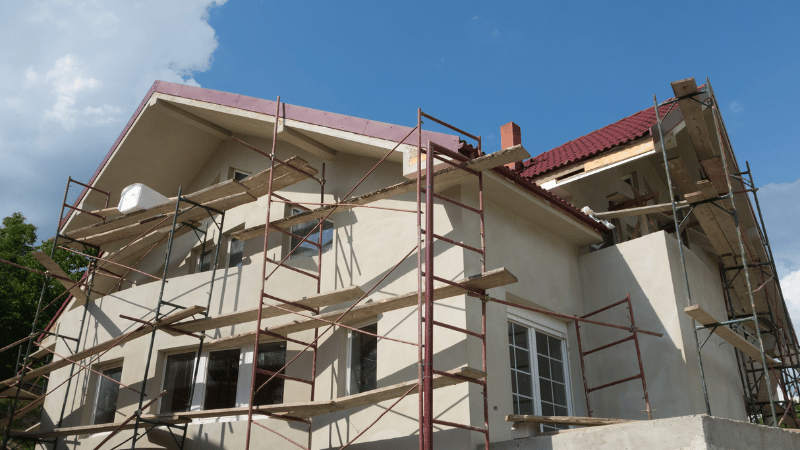Categories
London Airspace Development - How to Secure Finance

Struggling with severe land shortages and underutilised vertical spaces, London’s Airspace Development landscape is growing rapidly. The ability to build upwards presents lucrative prospects for developers who aren’t afraid of a complex project.
As the UK housing market struggles with a persistent crisis, innovative solutions are needed to overcome this issue.
The UK government has acknowledged the need for approximately 345,000 new homes each year, but the housing stock only increased by 244,000 homes in the 2019/20 period.
One of the key challenges lies within the intricate planning system, particularly in areas of high demand where housing shortages are most acute.
The scarcity of suitable land for development poses a significant obstacle, especially in urban and densely populated regions.
While rural areas might offer potential, the concentrated demand for housing primarily resides in cities where land availability is limited and often comes at a premium.
How can property developers and landlords meet the expanding housing supply in a cost-efficient manner while navigating the complexities of the planning process?
This is where airspace development can be an asset.
In this guide, we’ll take a look at how new and experienced property developers alike can secure finance for airspace development.
At Clifton Private Finance, we can guide you to the right lenders and navigate any potential pitfalls of airspace development finance in London and other areas.

Skip to:
London Airspace Development - What is it?
Tips for Securing Airspace Development for London Property
Finding the right Airspace Development Lenders
Addressing Leaseholder Concerns
Airspace Financing Made Attainable
London Airspace Development – What is it?
Airspace development refers to the vertical expansion of pre-existing buildings.
Land scarcity is becoming more of an issue in the UK for two main reasons:
-Rapid growth in major cities like London, Bristol and Manchester has contributed to a large population density in certain areas
-Desire to protect green spaces and forests in rural areas
Especially in urban landscapes, we’ve begun to turn our gaze turns skyward, discovering untapped opportunities to make use of the space we have.
However, this type of property development isn’t without its complexity. It requires careful planning and a robust strategy.
Airspace developments refer to the utilisation of 'air rights' within existing buildings, often involving the addition of two levels to the structure.
The term 'air rights' encapsulates the development potential above a property.
Notably, in 2020, airspace development gained specific permitted development rights, allowing for the construction of up to two additional floors for housing without the need for traditional planning permission.
See similar: Airspace Development Loans - The Comprehensive Guide
Case study: Our case study below details how we facilitated a £21.5M structured property finance rescue for a large development project in London
Tips for Securing Airspace Development for London Property
It's crucial to comprehend the intricacies of this process, including legal regulations and the feasibility of the development project within the context of London's property market.
Here’s what you should bear in mind:
Financial Planning
Estimate the costs associated with design, construction, legal procedures, and potential complications.
Also, evaluate the projected revenue from the new units to determine the viability of your investment.
Work with Professionals
Work with architects, engineers, and legal experts experienced in airspace development.
Their expertise ensures that your project adheres to regulatory requirements, maximises space utilisation, and is structurally sound.
Explore Your Funding Options
Consider various funding sources, such as airspace development loans, equity partnerships or joint ventures.
Each option has its advantages and challenges. Determine the financing route that aligns with your project's scope and financial capabilities.
Project Viability Assessment
Evaluate the demand for additional housing units in the London area where you plan to develop.
A thorough market analysis helps you understand the potential demand, pricing, and rental income – if you plan to transform airspace into BTL property.
Regulatory Compliance
London has stringent zoning and planning regulations. Familiarise yourself with these rules to ensure your project complies with local guidelines.
Obtaining the necessary permits and approvals is crucial to avoid legal issues down the road.
Risk Management
Anticipate unforeseen delays, budget changes, and challenges that may arise during the project.
Maintain a contingency fund to handle unexpected situations without disrupting the development process.
Exit Strategy Planning
Like with any type of loan, or development project, you must always have a clear exit strategy.
Lenders will want to review your plans. So, you should determine whether you intend to sell or lease the new units and plan accordingly.
Long-term profitability should guide your decisions.
Use a Specialist Broker
Lastly, working with a property development finance broker can help your chances of getting approved for a development loan.
At Clifton Private Finance, we’re experts in the London property landscape and can provide invaluable insights and guidance to aid your application.
We can help navigate complexities and aid you in making informed decisions throughout the development and financing process.
Not to mention, we have a wide-reaching network of notable and experienced lenders in airspace development.
We can source private lenders and specialist lenders and approach them on your behalf.

Finding the Right Airspace Development Lenders
Airspace development presents a cost-effective way for property developers to create new housing in populated areas like London.
While the UK government has eased development rules to encourage this, securing funding for such projects can be challenging due to their unique nature.
Moreover, many lenders are unfamiliar with the concept of airspace development, leading to uncertainty about feasibility and risk.
This challenge is exacerbated by the fact that the majority of lenders have set exposure limits, typically ranging from 25% to 50% of units within a building, including the existing apartments below.
Airspace development’s unconventional nature means this type of development differs from traditional building methods, so lenders unfamiliar with the complexities may doubt the success of these projects without a proven track record.
Due to limited precedents, evaluating risks accurately can also be difficult, so lenders may be more apprehensive about development loans of this nature.
Borrowers may potentially need to display detailed plans and all necessary documents to support their plans.
Despite these challenges, airspace development offers benefits such as increased housing, minimal disruption, and the preservation of existing structures.
As understanding grows, funding access may become more widespread.
In 2019, London Mayor Sadiq Khan granted a £10 million loan to Apex Airspace for capitalising on airspace development and addressing London's affordable housing shortage. With this kind of commitment and support, airspace development projects are surely on the rise.
If it's challenging to approach and locate lenders directly, we can find experienced and willing lenders for your airspace development needs.
Addressing Concerns and Benefits for Existing Leaseholders
One unique factor to account for in an airspace development project is working with the current leaseholders of the property you’re building on.
You’ll need to accommodate those already living in the property to minimise disruption of their day-to-day lives.
This responsibility is best handled by experienced developers who have encountered similar concerns in multiple projects.
During the initial assessment phase, many potential issues can be avoided. For instance, concerns regarding neighbouring properties' rights of light can be addressed through strategic design considerations, preventing future viability challenges.
Addressing Noise and Disruption Concerns
Existing leaseholders and nearby property owners may understandably express apprehensions about noise and disruption during the construction process.
One effective approach to alleviate these concerns is to execute a significant portion of the construction off-site.
Approximately 80% of the build can occur off-site, enabling swift attachment of pre-built sections to the existing structure.
This significantly reduces in-situ disruptions and can foster a smoother construction process.
Unlocking Property Value and Cost Savings
A notable benefit of airspace development is the potential for overall building upgrades, resulting in individual property value appreciation of around 3-10%.
Furthermore, it can allow residents reduced service charges, lower future renovation costs, and eliminate rooftop maintenance expenses.
This comprehensive approach not only addresses concerns but can also enhance the overall quality of living for leaseholders while delivering lasting financial advantages.
Securing Planning Permissions – What You Need to Know
Permitted development rights are applicable to properties not exceeding two stories when built atop existing purpose-built residential flats.
However, strict adherence to regulations concerning room dimensions and natural light infiltration remains imperative.
The building's construction should fall between 1 July 1948 and 5 March 2018, and the structure must boast a height of no less than three stories above ground level.
This eligibility also extends to higher staggered buildings, though new units must conform to stipulated ceiling height restrictions and constraints regarding roof height and external structures.
Despite these permitted development rights, the possibility of local objections should not be overlooked.
Engaging with planning officers at an early stage is prudent to address potential concerns proactively, especially within London, where these things can be more difficult.

Airspace Financing Made Attainable
Exploring the novel realm of selling airspace is a promising venture.
However, securing financing for such unique projects remains a significant challenge, given the unfamiliarity of many lenders with this concept.
Our platform, however, specialises in linking you with lenders who comprehend and endorse your vision.
Airspace projects typically involve significant renovation or Development Funding.
Importantly, funding costs can exceed conventional mortgages, but deferred payments until property sale might be possible.
As airspace development consists of constructing a new property yet to be valued, this type of finance hinges on post-refurbishment gross development value (GDV).
This means that the loan will be set against the eventual value of the development.
Consequently, airspace development finance is catered towards experienced property developers and investors, yet some lenders may still consider you if you are a new property developer.
Lenders will often need a comprehensive task breakdown, including costs and timelines – and your past project record will also be assessed.
Airspace development loans can range from £100,000 to £10,000,000, with potentially up to 70% of GDV.
The loan terms are short, typically between 18-24 months, with higher interest rates than a typical mortgage.
Of course, any type of property finance comes with additional fees to consider, such as arrangement fees, exit fees, and the initial valuation fee.
Work With Us
At Clifton Private Finance, we are your dedicated partners in navigating the intricate world of London airspace development finance.
Our specialisation lies in crafting tailored financial solutions for your unique project needs.
As seasoned experts in property finance, we can connect you with lenders who possess a profound understanding of airspace development, ensuring your financing aligns seamlessly with your project's distinctive requirements.
Leveraging our expansive network and comprehensive market access, we secure competitive interest rates and terms that provide you with a clear financial advantage.
Our adept team streamlines the decision-making process by offering expert guidance at every step of your financing journey.
With an award-winning client services team, we prioritise transparency and support, making complex financial decisions more accessible.
Our commitment to delivering clarity and assistance empowers you to navigate the financial landscape with confidence.
We diligently search for affordable and advantageous financing options that match your budget and objectives.
Connect with us today to discuss your airspace development needs and allow us to guide you in discovering the ideal financing solution tailored to your project's success.
Contact us at 0117 959 5094 or schedule a no-obligation consultation below to see what we can do for you.










